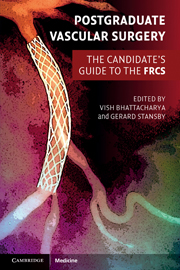Book contents
- Frontmatter
- Contents
- List of contributors
- Preface
- Section 1 Final FRCS vascular clinicals
- Section 2 Final FRCS vascular topics
- 1 Vascular risk factors and their management
- 2 Management of acute limb ischaemia
- 3 Chronic lower limb ischaemia, critical ischaemia and the diabetic foot
- 4 Endovascular and surgical options for peripheral revascularisation
- 5 Abdominal aortic aneurysms
- 6 Thoracic, thoracoabdominal and suprarenal aortic aneurysms
- 7 Aortic dissection
- 8 Popliteal artery aneurysms
- 9 Femoral artery aneurysms
- 10 Carotid, subclavian and vertebral disease
- 11 Diagnosis and management of thoracic outlet syndrome
- 12 Diagnosis and management of hyperhidrosis
- 13 Chronic mesenteric ischaemia
- 14 Acute ischaemic colitis
- 15 Vascular trauma
- 16 Indications and management of lower limb amputation
- 17 Leg swelling and lymphoedema
- 18 Varicose veins and chronic venous insufficiency
- 19 Management of deep vein thrombosis
- 20 Infection in vascular surgery
- 21 Vascular malformations
- 22 Vasospastic disorders and vasculitis
- 23 Critical care considerations and preoperative assessment for general and vascular surgery
- 24 Access surgery
- 25 Basic outline of solid organ transplantation
- Index
- References
18 - Varicose veins and chronic venous insufficiency
- Frontmatter
- Contents
- List of contributors
- Preface
- Section 1 Final FRCS vascular clinicals
- Section 2 Final FRCS vascular topics
- 1 Vascular risk factors and their management
- 2 Management of acute limb ischaemia
- 3 Chronic lower limb ischaemia, critical ischaemia and the diabetic foot
- 4 Endovascular and surgical options for peripheral revascularisation
- 5 Abdominal aortic aneurysms
- 6 Thoracic, thoracoabdominal and suprarenal aortic aneurysms
- 7 Aortic dissection
- 8 Popliteal artery aneurysms
- 9 Femoral artery aneurysms
- 10 Carotid, subclavian and vertebral disease
- 11 Diagnosis and management of thoracic outlet syndrome
- 12 Diagnosis and management of hyperhidrosis
- 13 Chronic mesenteric ischaemia
- 14 Acute ischaemic colitis
- 15 Vascular trauma
- 16 Indications and management of lower limb amputation
- 17 Leg swelling and lymphoedema
- 18 Varicose veins and chronic venous insufficiency
- 19 Management of deep vein thrombosis
- 20 Infection in vascular surgery
- 21 Vascular malformations
- 22 Vasospastic disorders and vasculitis
- 23 Critical care considerations and preoperative assessment for general and vascular surgery
- 24 Access surgery
- 25 Basic outline of solid organ transplantation
- Index
- References
Summary
Key points
Truncal varices are common with an age-adjusted prevalence of 40% in men and 32% in women
Varicosities may be primary or secondary due to previous deep vein thrombosis (DVT), pelvic obstruction or deep venous reflux
Patients present with discomfort, swelling, pain, pruritis, bleeding, thrombophlebitis and skin changes
Hand held Doppler has replaced the tourniquet test as a ‘bedside examination’ for evaluating incompetence of valves
Current treatments for varicose veins include conventional surgery, radiofrequency ablation, laser ablation and injection sclerotherapy (liquid or foam)
Surgery to the great saphenous vein involves high tie and stripping and has a recurrence rate of 15%–20%
Surgery to the small saphenous vein involves saphenopopliteal ligation, stripping and phlebectomy
Foam sclerotherapy and catheter ablation techniques using laser or radiofrequency can be used under local anaesthesia, but less is known about their long-term outcome
Chronic venous insufficiency affects between 7% and 9% of the adult population and is due to venous reflux, obstruction or calf pump failure
Clinical signs include swelling, venous eczema, pigmentation lipodermatosclerosis and ulceration
Multilayered compression is the gold standard used to heal venous ulceration
The Effect of Surgery and Compression on Healing and Recurrence (ESCHAR) trial showed a reduced ulcer recurrence rate with combined surgery and compression
Venous reconstruction is rarely performed and usually reserved for severe disease, resistant to other forms of treatment
Varicose veins
Epidemiology
Data from the Edinburgh Vein Study suggest a slightly greater prevalence of varicose veins in males compared to females (4 : 3.2).
- Type
- Chapter
- Information
- Postgraduate Vascular SurgeryThe Candidate's Guide to the FRCS, pp. 204 - 219Publisher: Cambridge University PressPrint publication year: 2011
References
- 2
- Cited by



